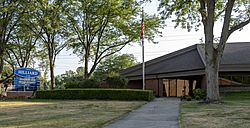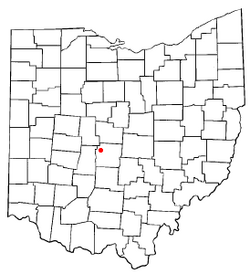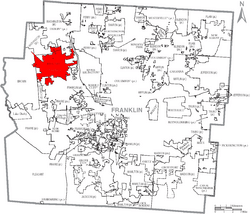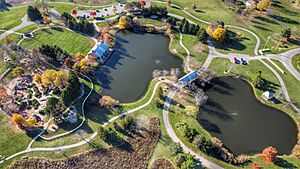Hilliard, Ohio facts for kids
Quick facts for kids
Hilliard, Ohio
|
|||
|---|---|---|---|

Hilliard City Hall
|
|||
|
|||

Location of Hilliard within Ohio
|
|||

Location of Hilliard within Franklin County
|
|||
| Country | United States | ||
| State | Ohio | ||
| County | Franklin | ||
| Area | |||
| • Total | 14.45 sq mi (37.42 km2) | ||
| • Land | 14.27 sq mi (36.96 km2) | ||
| • Water | 0.18 sq mi (0.46 km2) | ||
| Elevation | 932 ft (284 m) | ||
| Population
(2020)
|
|||
| • Total | 37,114 | ||
| • Estimate
(2023)
|
37,262 | ||
| • Density | 2,600.66/sq mi (1,004.11/km2) | ||
| Time zone | UTC-5 (Eastern (EST)) | ||
| • Summer (DST) | UTC-4 (EDT) | ||
| ZIP code |
43026
|
||
| Area code(s) | 614 and 380 | ||
| FIPS code | 39-35476 | ||
| GNIS feature ID | 2394381 | ||
| Website | www.hilliardohio.gov | ||
Hilliard is a city located in Franklin County, Ohio, in the United States. It's like a neighbor to the big city of Columbus. In 2020, about 37,114 people lived there. Hilliard is also part of Norwich Township.
Contents
History of Hilliard
In 1852, a man named John Reed Hilliard bought 10 acres of land in western Franklin County, Ohio. This area is located between two creeks, Big Darby Creek and the Scioto River. The town started around a train station called Hilliard's Station. This station was on the Piqua and Indiana Railroad line.
Hilliard's Station was a great spot for farmers to send their crops to market. It was also where they could get supplies. John Hilliard officially planned out the town on September 1, 1853.
Growth of Hilliard
For many years, the train station and Main Street were the heart of Hilliard. In 1854, a post office opened, and the town's name became simply Hilliard. On July 13, 1869, Hilliard officially became a village with 280 residents.
The first train station was built in 1886. It was used until 1962 when train services stopped. Today, the original train station has been fixed up. You can find it in Hilliard's historical Weaver Park.
Modern Hilliard Develops
In the 1950s, Hilliard grew a lot as three large neighborhoods were built. The city connected to the Columbus sewer and water systems in the 1960s. This helped Hilliard grow even more. On December 12, 1960, Hilliard officially became a city. Its population had reached 5,633 people.
Another big growth spurt happened in the early 1970s. This was after the I-270 outerbelt highway was finished. Hilliard today has a mix of homes and businesses. You can see many old and interesting houses in the historic district along Norwich Street.
Geography of Hilliard
Hilliard is surrounded by other cities and areas. To the east, it borders Columbus and Upper Arlington. To the north, it's next to Columbus and Dublin. South of Hilliard are Galloway and more of Columbus. To the west, you'll find open farmland.
Sometimes, you can even see the skyline of Downtown Columbus from Hilliard. This happens when you cross bridges.
Land and Water Area
The city of Hilliard covers about 13.34 square miles (34.55 square kilometers). Most of this area is land, about 13.17 square miles (34.11 square kilometers). A small part, about 0.17 square miles (0.44 square kilometers), is water.
Population and People
Hilliard has grown quite a bit over the years. Here's how its population has changed:
| Historical population | |||
|---|---|---|---|
| Census | Pop. | %± | |
| 1870 | 282 | — | |
| 1880 | 400 | 41.8% | |
| 1890 | 338 | −15.5% | |
| 1900 | 376 | 11.2% | |
| 1910 | 370 | −1.6% | |
| 1920 | 451 | 21.9% | |
| 1930 | 465 | 3.1% | |
| 1940 | 583 | 25.4% | |
| 1950 | 610 | 4.6% | |
| 1960 | 5,633 | 823.4% | |
| 1970 | 8,369 | 48.6% | |
| 1980 | 7,996 | −4.5% | |
| 1990 | 11,796 | 47.5% | |
| 2000 | 24,230 | 105.4% | |
| 2010 | 28,234 | 16.5% | |
| 2020 | 37,114 | 31.5% | |
| 2023 (est.) | 37,262 | 32.0% | |
| US Census | |||
Hilliard's Population in 2010
In 2010, Hilliard had 28,435 people living there. There were 10,198 households, which are groups of people living together. Most households (61.8%) were married couples. About 44.5% of households had children under 18.
The average age in Hilliard was 35.9 years old. About 30.1% of the people were under 18.
Culture and Fun in Hilliard
Hilliard is home to some interesting places. You can visit the Early Television Museum, which has old televisions. It also has the second largest First Responders Park in the United States. The city also has the Heritage Rail Trail, which is great for walking or biking.
A special item in Hilliard is a flagpole from the World Trade Center. This flagpole is not in a museum; it's in front of the fire department. The Hilliard Historical Society also has a historical village.
Annual Festivals and Events
Hilliard hosts many fun events each year:
- The Franklin County Fair
- The Old Hilliardfest Art & Street Fair
- A Fourth of July parade and fireworks show
- A weekly summer concert series called Celebration at the Station
Recreation and Parks
Hilliard's Recreation Department takes care of about 27 parks. The Heritage Rail Trail is a popular spot for outdoor activities. Its starting point is in Old Hilliard on Center Street. There are 41 miles of trails for different uses.
Transportation in Hilliard
Hilliard's main roads are Cemetery Road and Main Street/Hilliard Rome Road. While there are no major Ohio state routes directly in Hilliard, the city's eastern side is close to Interstate 270. This highway is a ring road that goes around Columbus. People often call it the "Outerbelt."
There are no major train lines for travel in Hilliard. However, there is a park and ride lot on Cemetery Road. This is close to I-270.
For air travel, Hilliard is served by John Glenn International Airport. This airport handles most commercial flights in the Columbus area. Hilliard is also very close to Don Scott Airport. This airport is used for general aviation and for Ohio State University aviation classes.
Education in Hilliard
The Hilliard City School District serves a large area. It includes all of Hilliard and parts of Columbus, Dublin, and Galloway.
The district has many schools:
- Elementary Schools (grades K-5): Alton Darby, Avery, Beacon, Britton, Brown, Darby Creek, Hilliard Crossing, Hilliard Horizon, Hoffman Trails, J.W. Reason, Norwich, Ridgewood, Scioto Darby, and Washington.
- Sixth-Grade Schools: Station and Tharp.
- Middle Schools (grades 7-8): Heritage, Weaver, and Memorial.
- High Schools (grades 9-12): Darby (Panthers), Davidson (Wildcats), and Bradley (Jaguars).
Hilliard also has two private schools:
- Saint Brendan School (a K-8 Roman Catholic school)
- Sunrise Academy (a K-8 Islamic school)
Notable People from Hilliard
- Mike Furrey - a former professional football player. He used to play wide receiver and safety. Now, he is the head coach for the Limestone Saints college football team.
See also
 In Spanish: Hilliard (Ohio) para niños
In Spanish: Hilliard (Ohio) para niños



